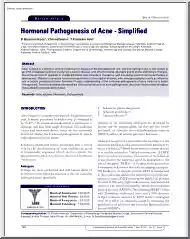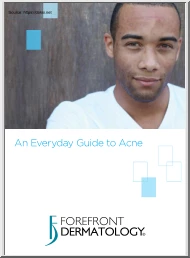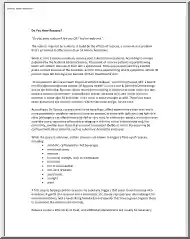No comments yet. You can be the first!
Content extract
Greater Manchester Guidelines for the Management of Acne Primary Care Adapted from Primary Care Dermatology Society guidance Nov 2015 Date: April 2019 Review: January 2022 Acne: A common chronic disorder affecting the hair follicle and sebaceous gland, in which there is expansion and blockage of the follicle and inflammation. There are several variants Red Flags: Refer immediately if: Severe psychological distress Uncontrolled acne developing scarring Nodulo‐cystic acne Diagnostic uncertainty Patient not responding to multiple therapeutic interventions (more than 2 antibiotics over 12 months). Patient presents to GP: History and examination to assess type, extent, severity of lesion(s) and patients’ quality of life. Discuss self‐care information Assessment of psychological distress. Mild acne (for self‐care) Comedones: blackheads and non‐inflamed papules. If comedones and other form of acne are present, treat the comedones first. Topical treatment only:
1st line: TRs 2nd line: Azelaic acid Antibiotics have no benefit Inflammatory/ papulopustular Moderate acne: Papules, pustules Topical combination products: adapalene+BPO, clindamycin+BPO, Isotretinoin+erythromycin, tretinoin+clindamycin. Severe acne: Nodules and cysts, scarring, persisting Combined therapy: TR + BPO +/‐ oral antibiotic Try for 3 months, however, if scarring is present by 6 weeks refer to local provider Patients should be referred straight to local provider, however, antibiotics and topical treatments can be initiated in general practice while waiting for an appointment. Topical treatments: Topical retinoids (TRs): for all grades of acne. Also advisable to use for long term maintenance as acne is a chronic condition. Azelaic acid may be beneficial in patients with darker skin where acne can cause hyperpigmentation. Benzyl peroxide (BPO) archetypal peeler (NB can cause bleaching of fabric). Irritation caused by TRs and BPO can be improved by gradual
introduction e.g by short contact initially and/or less frequent application. Concurrent use with light non‐comedogenic emollients may be useful. Pregnancy: Discontinue topical or oral retinoids and tetracyclines in the event of pregnancy. Use topical antibiotics, zinc or oral erythromycin. Discontinue treatment. Consider TRs as maintenance Review as appropriate TRs – advise patients regarding initial irritancy to improve compliance At 12 week review: If treatment goals achieved consider maintenance therapy and discontinue topical/systemic antibiotics. If treatment goals not achieved review adherence to treatment and/or consider alternative treatments. For all females assess risk of polycystic ovary syndrome and if acne flares with menses, and if so consider combined oral contraceptive pill. NB allow 6 months to assess response to hormonal therapy. Hormone therapy is not to be used as sole therapy if severe/ scarring acne. Unopposed progesterones (including long acting
reversible contraceptives) can worsen acne. Co‐cyprindiol (Dianette) is used in moderate to severe acne where other treatments have failed (see MHRA safety advice) Controlled after 3 months Not controlled after 3 months Combined therapy: improves adherence Try alternative treatments for a further 3‐9 months. Review every 3 months. Refer to local provider if patient not responding to multiple therapeutic interventions when applied sufficiently after 12 months. Refer immediately if scarring present. Maintain topical treatment Oral antibiotics: Treatments can take up to 3 months to take effect therefore prescribe for a minimum of 3 months before referral. Not to be used as sole treatment ‐ prescribe with a TR and/or a BPO. Tetracyclines (oxytetracycline) are first line and all show similar efficacy. Doxycycline, Lymecycline and Erythromycin (first line in pregnancy) are alternatives. Better adherence likely with lymecycline due to once daily dosage Routine use of minocycline not
recommended due to side effects. Trimethoprim is an option, but uncommonly used in primary care
1st line: TRs 2nd line: Azelaic acid Antibiotics have no benefit Inflammatory/ papulopustular Moderate acne: Papules, pustules Topical combination products: adapalene+BPO, clindamycin+BPO, Isotretinoin+erythromycin, tretinoin+clindamycin. Severe acne: Nodules and cysts, scarring, persisting Combined therapy: TR + BPO +/‐ oral antibiotic Try for 3 months, however, if scarring is present by 6 weeks refer to local provider Patients should be referred straight to local provider, however, antibiotics and topical treatments can be initiated in general practice while waiting for an appointment. Topical treatments: Topical retinoids (TRs): for all grades of acne. Also advisable to use for long term maintenance as acne is a chronic condition. Azelaic acid may be beneficial in patients with darker skin where acne can cause hyperpigmentation. Benzyl peroxide (BPO) archetypal peeler (NB can cause bleaching of fabric). Irritation caused by TRs and BPO can be improved by gradual
introduction e.g by short contact initially and/or less frequent application. Concurrent use with light non‐comedogenic emollients may be useful. Pregnancy: Discontinue topical or oral retinoids and tetracyclines in the event of pregnancy. Use topical antibiotics, zinc or oral erythromycin. Discontinue treatment. Consider TRs as maintenance Review as appropriate TRs – advise patients regarding initial irritancy to improve compliance At 12 week review: If treatment goals achieved consider maintenance therapy and discontinue topical/systemic antibiotics. If treatment goals not achieved review adherence to treatment and/or consider alternative treatments. For all females assess risk of polycystic ovary syndrome and if acne flares with menses, and if so consider combined oral contraceptive pill. NB allow 6 months to assess response to hormonal therapy. Hormone therapy is not to be used as sole therapy if severe/ scarring acne. Unopposed progesterones (including long acting
reversible contraceptives) can worsen acne. Co‐cyprindiol (Dianette) is used in moderate to severe acne where other treatments have failed (see MHRA safety advice) Controlled after 3 months Not controlled after 3 months Combined therapy: improves adherence Try alternative treatments for a further 3‐9 months. Review every 3 months. Refer to local provider if patient not responding to multiple therapeutic interventions when applied sufficiently after 12 months. Refer immediately if scarring present. Maintain topical treatment Oral antibiotics: Treatments can take up to 3 months to take effect therefore prescribe for a minimum of 3 months before referral. Not to be used as sole treatment ‐ prescribe with a TR and/or a BPO. Tetracyclines (oxytetracycline) are first line and all show similar efficacy. Doxycycline, Lymecycline and Erythromycin (first line in pregnancy) are alternatives. Better adherence likely with lymecycline due to once daily dosage Routine use of minocycline not
recommended due to side effects. Trimethoprim is an option, but uncommonly used in primary care




